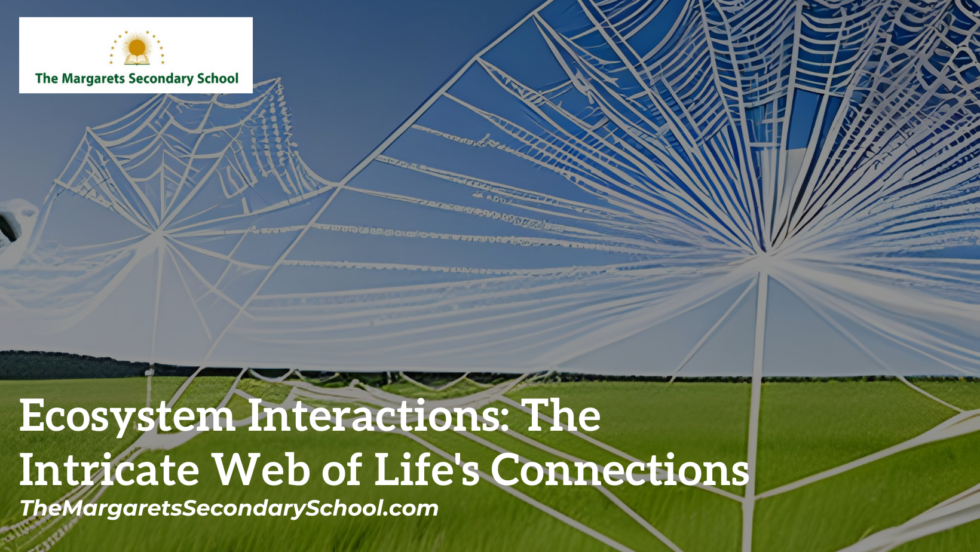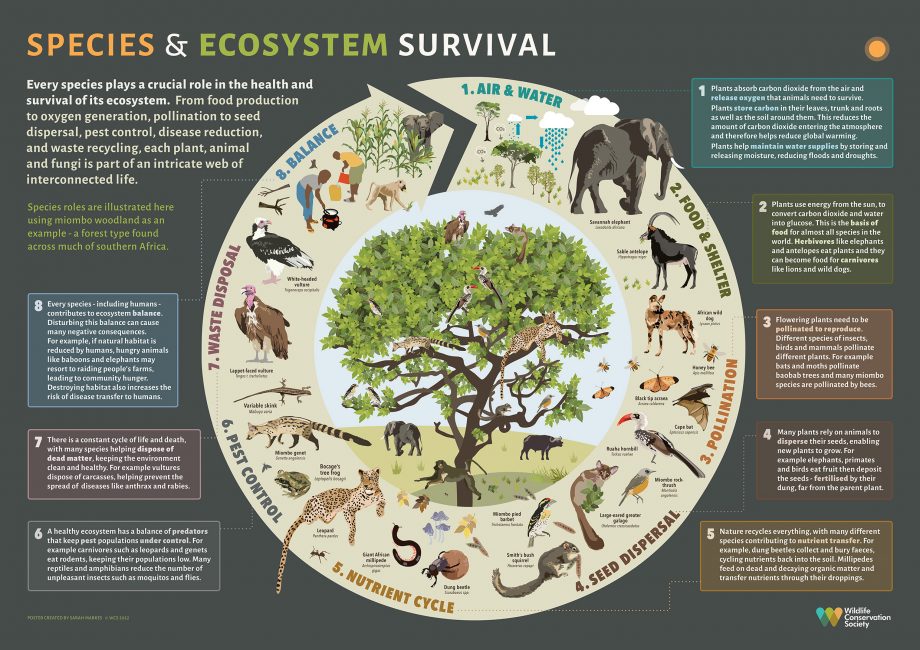The Intricate Web of Life: Understanding Ecosystems

Ecosystems are the fundamental units of ecological organization, representing a complex and dynamic interplay between living organisms and their non-living environment. They encompass a vast range of scales, from a tiny puddle teeming with microscopic life to a sprawling forest stretching across continents. Understanding ecosystems is crucial for comprehending the intricate web of life on Earth and for addressing pressing environmental challenges like climate change and biodiversity loss.
Defining the Ecosystem:
An ecosystem can be defined as a community of interacting organisms (biotic factors) and their physical environment (abiotic factors), functioning as a unified and self-regulating system. This system is characterized by the flow of energy and the cycling of nutrients.
- Biotic Factors: These are the living components of an ecosystem, including plants, animals, fungi, bacteria, and other microorganisms. They interact with each other through various relationships, such as competition, predation, mutualism, and parasitism.
- Abiotic Factors: These are the non-living components of an ecosystem, such as sunlight, water, temperature, soil, air, and minerals. They influence the distribution and abundance of organisms and play a vital role in the cycling of nutrients.
Components of an Ecosystem:
Ecosystems are typically structured around key components:
- Producers (Autotrophs): These organisms, primarily plants and algae, are capable of producing their own food through photosynthesis. They convert sunlight, water, and carbon dioxide into energy-rich organic compounds, forming the base of the food chain.
- Consumers (Heterotrophs): These organisms obtain their energy by consuming other organisms. They are classified into different trophic levels based on their feeding habits:
- Primary Consumers (Herbivores): Eat producers (e.g., deer, grasshoppers).
- Secondary Consumers (Carnivores): Eat primary consumers (e.g., snakes, foxes).
- Tertiary Consumers (Top Carnivores): Eat secondary consumers (e.g., lions, eagles).
- Omnivores: Eat both producers and consumers (e.g., bears, humans).

- Decomposers (Detritivores): These organisms, primarily bacteria and fungi, break down dead organic matter (detritus) into simpler substances. They recycle nutrients back into the ecosystem, making them available for producers.


Energy Flow and Trophic Levels:
Energy flow within an ecosystem follows a unidirectional path, starting with the sun. Producers capture solar energy through photosynthesis and convert it into chemical energy stored in organic molecules. This energy is then transferred to consumers when they eat producers, and subsequently to other consumers as they feed on each other.
Each feeding level in the ecosystem is called a trophic level. The first trophic level consists of producers, the second of primary consumers, the third of secondary consumers, and so on. Only about 10% of the energy stored in one trophic level is transferred to the next. The remaining 90% is lost as heat during metabolic processes. This energy loss explains why food chains are typically limited to four or five trophic levels.
Nutrient Cycling:
Unlike energy, nutrients are recycled within an ecosystem. Key nutrient cycles include:
- Water Cycle (Hydrologic Cycle): Involves the continuous movement of water between the atmosphere, land, and oceans through processes like evaporation, condensation, precipitation, and runoff.
- Carbon Cycle: Involves the movement of carbon through the atmosphere, oceans, land, and living organisms. Photosynthesis removes carbon dioxide from the atmosphere, while respiration and decomposition release it back.
- Nitrogen Cycle: Involves the conversion of nitrogen gas in the atmosphere into forms that plants can use. This process is largely driven by bacteria through nitrogen fixation, nitrification, and denitrification.
- Phosphorus Cycle: Involves the movement of phosphorus through rocks, soil, water, and living organisms. Phosphorus is essential for DNA, RNA, and ATP production.
Types of Ecosystems:
Ecosystems can be broadly classified into two main categories:
- Terrestrial Ecosystems: These ecosystems are found on land and are characterized by their climate, vegetation, and animal life. Examples include:
- Forests: Dominated by trees, providing habitat for a wide range of organisms. Different types of forests exist, such as tropical rainforests, temperate deciduous forests, and boreal forests.
- Grasslands: Dominated by grasses and herbaceous plants, supporting grazing animals and burrowing creatures. Examples include prairies, savannas, and steppes.
- Deserts: Characterized by low rainfall and sparse vegetation, with organisms adapted to survive in arid conditions.
- Tundra: Found in cold regions with permafrost, supporting low-growing vegetation and migratory animals.
- Aquatic Ecosystems: These ecosystems are found in water and are characterized by their salinity, depth, and nutrient levels. Examples include:
- Freshwater Ecosystems: Include lakes, rivers, streams, and wetlands, supporting a diverse range of aquatic plants and animals.
- Marine Ecosystems: Include oceans, coral reefs, estuaries, and coastal wetlands, supporting a vast array of marine life.
Ecosystem Services:
Ecosystems provide a wide range of essential services that benefit humans, including:
- Provisioning Services: Provide tangible resources like food, water, timber, and medicines.
- Regulating Services: Regulate climate, air quality, water purification, and pollination.
- Supporting Services: Underpin all other ecosystem services, including nutrient cycling, soil formation, and primary production.
- Cultural Services: Provide recreational, aesthetic, and spiritual benefits.
Threats to Ecosystems:
Ecosystems are facing increasing threats from human activities, including:
- Habitat Destruction and Fragmentation: Conversion of natural habitats for agriculture, urbanization, and infrastructure development.
- Pollution: Introduction of harmful substances into the environment, such as pesticides, heavy metals, and plastics.
- Climate Change: Alteration of global weather patterns, leading to changes in temperature, precipitation, and sea levels.
- Overexploitation of Resources: Unsustainable harvesting of plants and animals, leading to population declines and ecosystem degradation.
- Invasive Species: Introduction of non-native species that can outcompete native organisms and disrupt ecosystem function.
Conservation and Management of Ecosystems:
Protecting and restoring ecosystems is essential for maintaining biodiversity, ensuring human well-being, and mitigating climate change. Conservation strategies include:
- Establishing Protected Areas: Creating national parks, wildlife reserves, and other protected areas to safeguard biodiversity and ecosystem integrity.
- Sustainable Resource Management: Implementing practices that minimize the impact of human activities on ecosystems, such as sustainable forestry, agriculture, and fisheries.
- Restoration Ecology: Rehabilitating degraded ecosystems through techniques like reforestation, wetland restoration, and soil remediation.
- Reducing Pollution: Implementing policies to reduce pollution from industrial, agricultural, and urban sources.
- Combating Climate Change: Reducing greenhouse gas emissions to mitigate the impacts of climate change on ecosystems.
Conclusion:
Ecosystems are complex and interconnected systems that are vital for life on Earth. Understanding the structure, function, and dynamics of ecosystems is crucial for addressing environmental challenges and ensuring the long-term sustainability of our planet. By implementing effective conservation and management strategies, we can protect these valuable resources and ensure that future generations can benefit from the services they provide.
Frequently Asked Questions (FAQ):
Q1: What is the difference between an ecosystem and a biome?
A: A biome is a large geographic area characterized by specific climate conditions, plant communities, and animal life. It’s a broader classification than an ecosystem. An ecosystem is a specific community of interacting organisms and their physical environment within a biome. For example, a forest is a biome, while a specific stand of trees, along with the animals, fungi, and soil within that stand, would be an ecosystem.
Q2: How does biodiversity contribute to ecosystem stability?
A: Biodiversity, the variety of life in an ecosystem, is crucial for its stability and resilience. A diverse ecosystem is better able to withstand disturbances, such as droughts, floods, or pest outbreaks. Different species play different roles in the ecosystem, and if one species is lost, other species can often compensate. A less diverse ecosystem is more vulnerable to collapse if a key species is removed.
Q3: What is the role of keystone species in an ecosystem?
A: A keystone species is a species that has a disproportionately large impact on the structure and function of an ecosystem relative to its abundance. Their presence or absence can significantly alter the ecosystem’s dynamics. Examples include sea otters in kelp forests, beavers in wetlands, and wolves in temperate forests.
Q4: What are the main causes of ecosystem degradation?
A: The main causes of ecosystem degradation are habitat destruction and fragmentation, pollution, climate change, overexploitation of resources, and invasive species. These factors are often interconnected and driven by human activities.
Q5: How can individuals contribute to ecosystem conservation?
A: Individuals can contribute to ecosystem conservation in many ways, including:
- Reducing their carbon footprint: Conserving energy, using public transportation, and adopting a plant-based diet.
- Conserving water: Using water efficiently and avoiding water pollution.
- Reducing waste: Recycling, composting, and reducing consumption.
- Supporting sustainable businesses: Choosing products and services that are environmentally friendly.
- Protecting habitats: Planting native trees and shrubs, avoiding the use of pesticides, and supporting conservation organizations.
- Educating others: Raising awareness about environmental issues and inspiring others to take action.
Q6: What is the difference between a food chain and a food web?
A: A food chain is a linear sequence of organisms through which nutrients and energy pass as one organism eats another. It represents a simplified view of feeding relationships in an ecosystem. A food web, on the other hand, is a more complex and realistic representation of feeding relationships, showing the interconnectedness of multiple food chains within an ecosystem.
Q7: How does climate change affect ecosystems?
A: Climate change affects ecosystems in numerous ways, including:
- Changes in temperature and precipitation patterns: Leading to shifts in species distributions and altered ecosystem processes.
- Sea level rise: Threatening coastal ecosystems, such as mangroves and salt marshes.
- Ocean acidification: Harmful to marine organisms, particularly those with shells and skeletons.
- Increased frequency and intensity of extreme weather events: Damaging ecosystems and disrupting ecological processes.
- Changes in growing seasons: Affecting plant phenology and impacting food availability for animals.
Conclusion:
The study of ecosystems provides a crucial framework for understanding the interconnectedness of life on Earth. By recognizing the intricate relationships between living organisms and their environment, we can better appreciate the value of these natural systems and the services they provide. However, ecosystems face unprecedented threats from human activities, demanding urgent action to protect and restore them. Through sustainable practices, responsible resource management, and a commitment to conservation, we can ensure the long-term health and resilience of ecosystems, safeguarding the well-being of both present and future generations. The future of our planet depends on our ability to understand and protect the intricate web of life that sustains us all.
